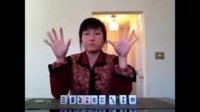By Emy Louie, Edited by Michael Morse
Went to a six hour Buddhist Chinese calligraphy retreat today—10 am – 4 pm. We had to be quiet during the entire time—including lunch.
About 30 people showed up to at the temple. All were Chinese except two or three people: I noticed one Hispanic woman in her 20s and a white man in his 50s who appeared to be with his Chinese wife. There was a Chinese lady in her 80s using a walker.
The retreat was conducted in Mandarin. Now, I’m familiar with common Mandarin from the English sub-titled Chinese movies I watched as a kid, language tapes, and the banter of Mandarin Chinese speakers at restaurants, stores and gatherings in Chinatown where I grew up; however the monks at this retreat spoke more formal Mandarin which I did not fully understand so I listened to the English translation using an earpiece.
Of course, as a Chinese cultural center, the Buddhist temple has hosted groups of more than 25 Cantonese speakers as well. That is a lot of Cantonese speakers in one place considering this is Raleigh, not San Francisco, New York City or Boston.
Although I cannot decipher an entire Chinese text, I know the meaning of basic Chinese characters and the order in which to draw the strokes of the characters. Further, all of the characters were drawn so I traced over the Chinese characters with a modern looking calligraphy brush that resembled a soft “sharpie” marker. I traced over a Sutra that repeated itself a number of times. And when it was 4 pm, we just stopped writing.
The female monks and the receptionists talk to me in Mandarin. I learn the language mainly through context. For example, during a prior visit to the temple, the monk, right after lunch, asked me “Are you full?” which is what Chinese people ask after a meal. So I learned that Mandarin phrase.
During the calligraphy, I was asked to sit on two cushions, eight inches off the ground, while people older than me sat on the western style seats, at tables.
In the morning, I was mainly thinking about lunch.
AT our buffet-style lunch, we were served rice soup that contained edamame, carrots and taro, among other things. Condiments with the soup included pickles and something else which I don’t know the name of. Lunch was very Chinese vegetarian!
Lunch was so quiet, I could hear the crunch of someone sitting across from me, biting on an apple. Because there was no talking, it was almost as if “only one person was eating lunch” instead of 30 people eating lunch. Oddly, instead of feeling alone, I felt so unified with everyone else in the room.
After lunch, I was thinking about how full I was. By 3:30pm, I was getting slightly restless.
The whole time, I was thinking of what I was going to tell people about this retreat. While doing the calligraphy, I had up and down emotions: at one point, I was feeling self-satisfied about my calligraphy and then next moment—disgusted at my poor technique.
Because it was so quiet, I could observe every emotion and thought as they arose. Overall, the retreat tested concentration and self-control skills. If not, one would likely quit early and the results would have been apparent in the calligraphy.
Schedule
10-10:30am registration and meditation on your own
10:30am – 11:50am calligraphy
12noon-1pm lunch
1pm – 1:50pm calligraphy
2pm – 2:20 pm exercises in a group setting
2:20 pm – 3:50pm calligraphy
3:50 pm lecture and closing prayer
4:00 pm we could talk again!

